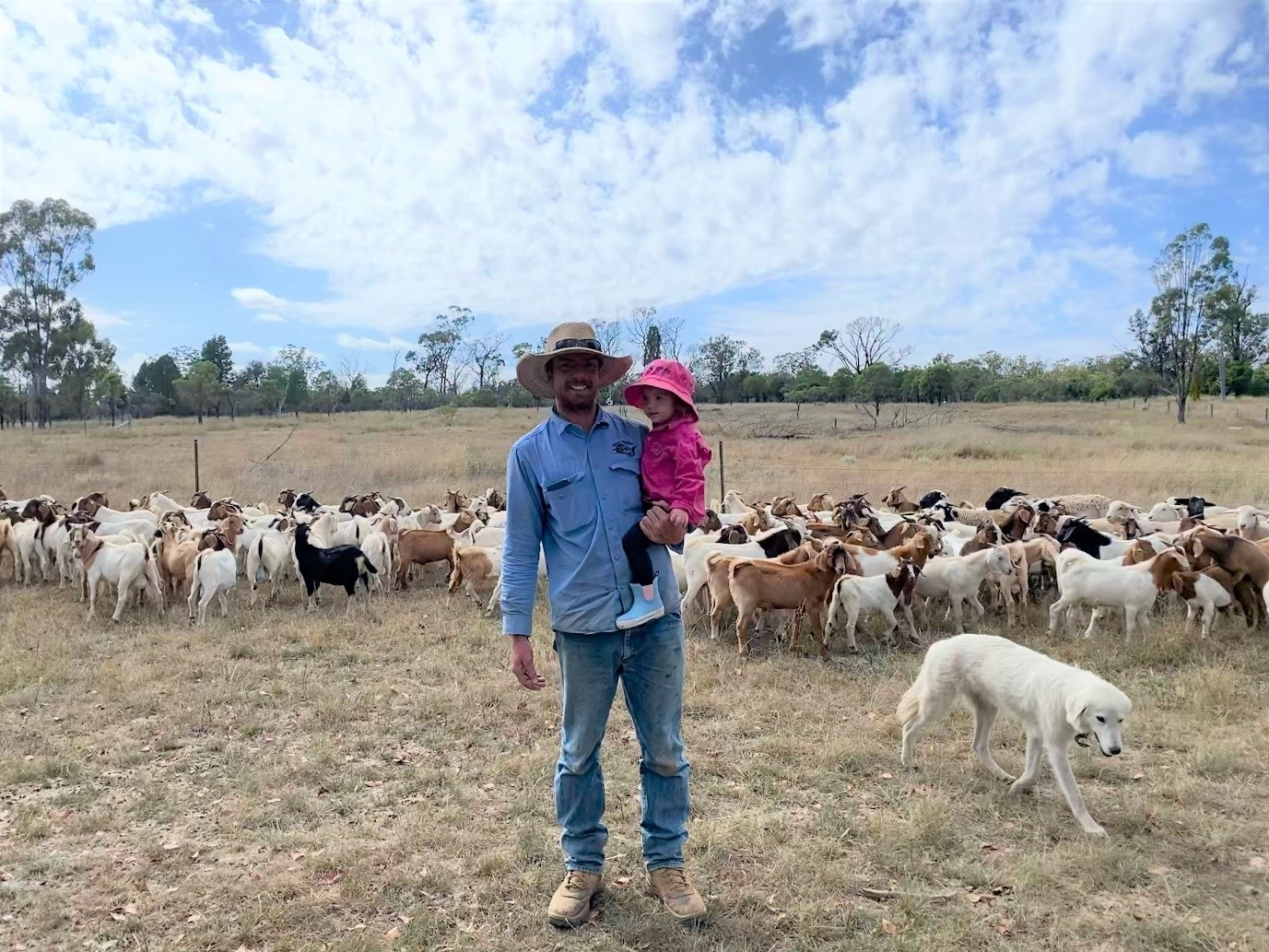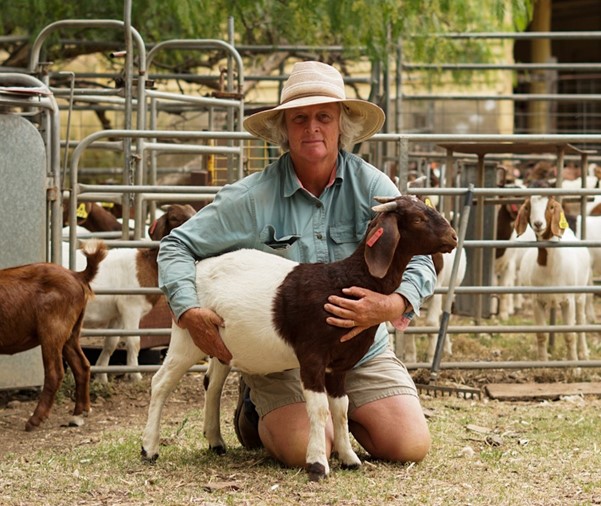Kids+ project identifying goat fertility issues
07 March 2023
 Goats in the stock lifter which researchers are using in the Kids+ project to collect data. Credit: Louw Hoffman.
Goats in the stock lifter which researchers are using in the Kids+ project to collect data. Credit: Louw Hoffman.
Key points:
- Body condition score, buck fertility and buck-to-doe ratios are emerging as key issues for producers from the Kids+ research project.
- Researchers have started collecting data on more than 9,000 goats from 12 Queensland producers.
- Data from NSW producers will start to be collected this month after flooding prevented researchers from accessing properties.
Preliminary findings from Kids+, the largest goat industry research project ever undertaken in Australia, have flagged key issues for goatmeat producers to consider when addressing herd fertility.
The five-year, $3.7 million project is being funded through the MLA Donor Company in partnership with the University of Queensland (UQ).
Its aim is to improve reproductive performance in goats to increase productivity and profitability on-farm.
To date, 12 Queensland goatmeat producers have signed-up to the project, with data being collected on more than 9,000 goats.
More producers in NSW are also involved in the project, with researchers set to travel to NSW this month to start collecting data after flooding prevented them from accessing properties.
Some participating producers have also captured historical data which researchers will analyse.
The producers across both states are drawn from a mix of production systems – extensive, semi-intensive and intensive.
Findings to date
Professor Louw Hoffman, Professor of Meat Science Centre for Nutrition and Food Sciences within the Queensland Alliance for Agriculture and Food Innovation (QAAFI) at UQ, is leading the project.
Professor Hoffman said from data gathered so far and talking with participating producers, three key issues had emerged as impacting herd fertility.
“What’s clear now is that the body condition score and then nutrition of does before they get mated and during pregnancy, is definitely playing a role in fertility,” Professor Hoffman said.
“Data are showing that if the body condition scores are good, it results in an average of 2.4 to 2.6 kids per doe.
“Another key issue is buck fertility. A producer decided to do a fertility evaluation of semen on the bucks before mating, and the testing found four of the 24 bucks they were going to use were infertile.
“That raises the question, why are people buying goats, and not asking for a fertility certificate for a buck? Cattle and sheep producers ask for it, so why don’t goat producers?
“I’d like to see a more aggressive seeking of information from a potential buyer. It’s such a core role in your productivity,” Professor Hoffman said.
Professor Hoffman said buck-to-doe ratio and potential overuse of bucks has emerged as another issue.
“Producers talk about putting a buck-to-doe ratio of anything from 1:30 to 1:50. If you have a breeding season and you monitor the activity, a buck will jump the same doe three or four times, but each time they do, they are decreasing the number of sperm that are mature.
“That raises the question – using this ratio, which comes from extensive systems where bucks are in with does the whole time, are we not overusing our bucks? If I talk to some producers who have a six or five-week mating period, some of the later born kids have abnormalities, but it’s not genetics causing that, it’s the sperm causing that.”
Professor Hoffman said participating producers were excited to be involved and collecting data.
Participating producers

Queensland goat producer, Pieter van Jaarsveld. Credit: Louw Hoffman.
Queensland goat producer, Pieter van Jaarsveld, Sunset Hill Boer Goats, Inglewood, is the Kids+ project manager and has goats in the trial.
“I’ve been involved in other goat trials with UQ and MLA and I did my honours thesis on a goat project involving similar data related to what this project is looking at,” Pieter said.
“The fact I was already doing research work on this topic but on a smaller scale meant it was a natural evolution to become involved in this project and go forward and get more data on a larger scale.
“It means we can benchmark goats as a whole as much as we can industry-wise and of course on-farm.”
Pieter runs around 2,000 breeding does, with all does and bucks individually eID tagged to enable data collection and full traceability.
He says the data Kids+ will collect over five years will provide producers with value at both an on-farm level and an industry level at a critical time for the industry.
“It’s a project where we get to measure kids being born, growing up and having kids over this whole period so you get more accurate data,” Pieter said.
“Producers in the project are from different production systems, so we get this wealth of data. We can compare it to various management methods in the industry to get a much clearer picture on what’s happening to goat numbers, genetics-wise and production-wise.
“It will enable the industry to see what can be achieved in collecting data and get more out of the data to help their business, as well as the potential to see what animals are doing on an individual basis as opposed to a mob,” Pieter said

Angus Ramsey and daughter Zara. Credit: Louw Hoffman.
South-west Queensland goatmeat producer, Angus Ramsey of ‘Old Paisley’, Inglewood, is among the producers participating in the Kids+ project.
Angus, his wife Emily, daughter, Zara, and his parents, Peter and Julie, currently join 885 does, ranging from Rangeland to Boer goats and F1s, turning off goats in the 30kg to 34kg liveweight range.
“We’re really excited about the Kids+ project and collecting data,” Angus said.
“We have 155 first- and second-cross weaner does that have been tagged with RFID tags so far as part of the project. We currently have 730 does kidding out, and once those kids are weaned, we will tag those does and all of their kids.
“We will scan and weigh the goats and use the data to help make management decisions, rather than making decisions based on visual assessments. Particularly when it gets dry, we will be able to offload does based on their performance data because the data doesn’t lie.
“The data will also help inform other aspects of our business such as supplementary feeding programs when our does are kidding,” Angus said.
The Ramseys have been part of the goatmeat industry for four years and have focused on improving their herd genetics in that time.
“While the base of our herd was Rangeland, we have gone hard on improving genetics and buying in quality Boer and Kalahari billies,” Angus said.
“We produce F1 and F2 billies which we sell to other local goat producers. We run our operation across 2,000 acres, so we need it to be profitable and producing goats that are tough enough to thrive on some of our Traprock country is important.”

Queensland seedstock producer, Helen Darlington. Credit: Louw Hoffman.
Queensland seedstock producer, Helen Darlington of Yarrabee Boer Goat Stud, Goombungee, said she was motivated to participate in Kids+ to help the industry develop and mature.
For the Kids+ project, data is being collected on approximately 100 of Helen’s breeding does and their progeny.
Helen is also supplying data she has collected over the past 25 years for researchers to analyse.
“I collect a lot of data and have been in the industry a long time. All the goats I breed are single sire mated so I know the parentage history of every goat I’ve bred,” Helen said.
“I wanted to have a role in contributing to helping the goat industry evolve and also play a future role in providing advice to producers. I always have animal welfare at the forefront of my mind so I also thought it would be interesting to see comparisons of data on things like survival rates and multiplication rates.
“There are many producers who are new to the industry and for some, goats have been more of an opportunistic venture as opposed to a carefully managed operation.
“This project will provide a wealth of information to producers about what they can achieve compared to what they are achieving from a productivity, profitability and welfare perspective,” Helen said.


